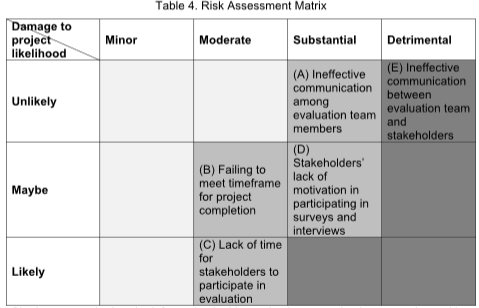Partnership accounting does not:
A. Tax the business entity.
B. Allocate net loss to each partner according to the partnership agreement.
C. Use a capital account for each partner.
D. Allocate net income to each partner according to the partnership agreement.
E. Use a withdrawals account for each partner.
Answer: A
You might also like to view...
What could the team done to help Sheena understand better about the risk factors?
Sheena, a managing director of a non-profit organization, reviews an evaluation
proposal submitted by a team of evaluators who plan to look at Sheena’s community outreach program. Sheena reads the last section “Assessments of Feasibility and Risk Factors” carefully, which contains a paragraph of description and a table as shown below.
4.2. Risk Factors The evaluation team has identified several risk factors as indicated in Table 4. The team may uncover other risk factors while completing the evaluation project. However, without resolving issues associated with the serious risk factors, the team may not be able to continue with the implementation phase of the project; it may be better to delay or forgo it.

She is unsure whether the information in this section is suggesting her to continue with the implementation phase of the project or cancel the project.
a. Merge the Risk Factors section with the feasibility assessment section.
b. Move the Fisk Factors section to the Organization section.
c. Insert additional risk factors that are unlikely to happen.
d. Describe individual risk factors and methods to manage them.
Greater product variety and shorter life cycles result in shorter windows of opportunity for a supply chain to achieve fit
Indicate whether the statement is true or false.
A bill of material contains the standard material quantities that are required to produce one unit of end product.
Answer the following statement true (T) or false (F)
A random sample of 10 university students was surveyed to determine the amount of time spent weekly at the library. The times are: 13, 14, 5, 6, 8, 10, 7, 12, 15, and 3 . If the times are normally distributed with a standard deviation of 5.2 hours, estimate with 90% confidence the mean weekly time at the library by all university students